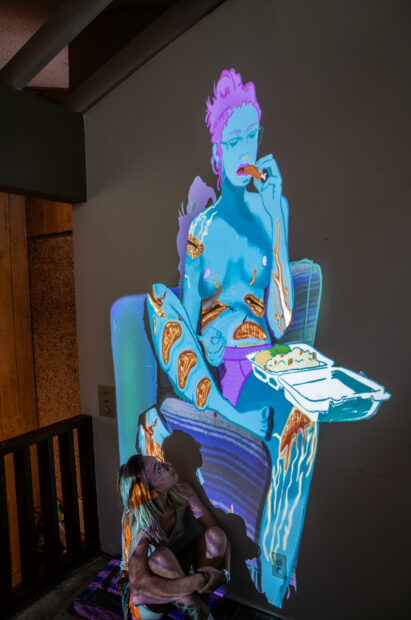Big Medium and the LINE Austin have announced the upcoming artists chosen for the LINE Residency. Suzanne Wyss, Casey Alfstad, Christina Moser , Love Muwwakkil, Preston Gaines, and Diego Miró-Rivera have been selected to participate, and will be working within the LINE Austin hotel for six-week periods throughout the year. The artists will receive a private studio, a living space, and access to hotel amenities. They will engage the public by hosting community events, such as artist talks or workshops, and will also have open studio hours. Four of the artists this year are based in Austin, while two are not — Ms. Moser is living and working in Marfa, and Mr. Gaines is based in Houston.
The LINE Residency began in 2019 as a partnership between Big Medium and the downtown hotel; it expanded to include non-Austin-based artists last year. Learn about the residency and see a list of former residents here. Learn about this year’s residents below, via biographies provided by Big Medium.
Suzanne Wyss is a multi-disciplinary artist focusing on installation and sculpture, transforming industrial materials into organic forms. Using repetition and the inherent “isness” of each material, they are transformed into something altogether new, morphed into natural form and movement. Wyss received her MFA in sculpture from Indiana University in 2013 and her BFA in sculpture and ceramics from the University of Minnesota, Duluth, in 2010. She originates from the Black Hills of South Dakota. Since becoming a Texan in 2013 her most notable previous works are a permanent installation at Springdale General, Thinkery ATX, and a site-specific installation for the Facebook Artist in Residence Program. In the spring of 2023, Wyss received her master’s in Landscape Architecture at the University of Texas at Austin to further explore the integration between sculpture and landscape.
Casey Alfstad (she/they) is a video sculptor and new media art designer from Springs, New York, based in Austin, Texas. Alfstad finds a parallel between experimental tech and queer culture in that both are proactively designing what the future can look like. When she’s not producing her own sculptures, she is working alongside museums, galleries, and artists to design digital capabilities into their creative practices. Alfstad is also the co-founder of @ConceptAnimals, a femme artist run publication.
Christina Moser is a multi-disciplinary artist working to call attention to the infinite. Her work examines liminality—the pace of change, things that exist on a temporal timeline. Primarily painting large-scale works with an airbrush, using emotive colors, symbolic geometries, impossible objects, and references from personal experiences blur into an abstract vocabulary. Observations of natural, seasonal, and daily change function as a reflection of the self and the unconscious. Christina grew up in Houston and received a BFA in Design from the University of Texas at Austin. She lives and works with her husband and dog in Marfa, TX.
Love Muwwakkil is a freelance performer, teacher, choreographer, writer, and maker. She is the founder of Love Notes in Motion, offering movement workshops and embodied leadership through movement and play. Receiving an MFA in Dance and Social Justice from UT Austin, her work is at the intersection of experimental dance, improvisation and installation. Using the body as the main vehicle of expression, her work grapples with these questions: what does liberation feel like in my body? How do we navigate and dismantle the imposed colonial archive that lives in our bodies? What strategies can we use to reconnect or resource the inherent liberation in our bodies and instill deep trust of self? What happens when we stop performing liberation and make it a lived experience?
Preston Gaines, an artist, architect, and industrial designer based in Houston, navigates the convergence of technology and the natural world through my work in sculpture, projection-mapping, and interactive installations. Operating under the artistic alias Inanimate Nature, his practice seeks to blur the distinctions between the natural and artificial, challenging conventional views of the environment with a vision deeply rooted in the fusion of digital and natural realms. Drawing profound inspiration from ancient cultures, notably Kemet (ancient Egypt), his work intertwines symbolism, numerology, geometry, and nature to navigate the realms of self-development and spiritual inquiry. This rich historical context underpins his artistic endeavors, compelling him to craft experimental projects that reflect upon the “Post-Natural Landscapes” — a concept acknowledging the irreversible human imprint on nature. His art embodies a reimagined understanding of nature, one that embraces the intricate dance between human intervention and the natural order.
Diego Miró-Rivera was born in Austin, Texas to parents from Puerto Rico and Spain. Diego’s work is focused on site-specificity, the natural world, how humans relate through the manipulation of space. Some of his works are of immense scale, snow or grass drawings tracking several kilometers, other works fit in the palm of a hand, featuring materials that often go unnoticed, like a cigarette butt or a seed. Diego graduated from Yale University this past May, with honors in Art and Cognitive Science, and was awarded the Sudler Prize for the Creative Arts at commencement. Other formative experiences include a residency at the Norfolk School of Art, archeological research on the Ancient Maya in Belize (Gurney Fellowship ‘22), a field study of Japan’s gardens (William Hotchkiss Fellowship ‘23).



